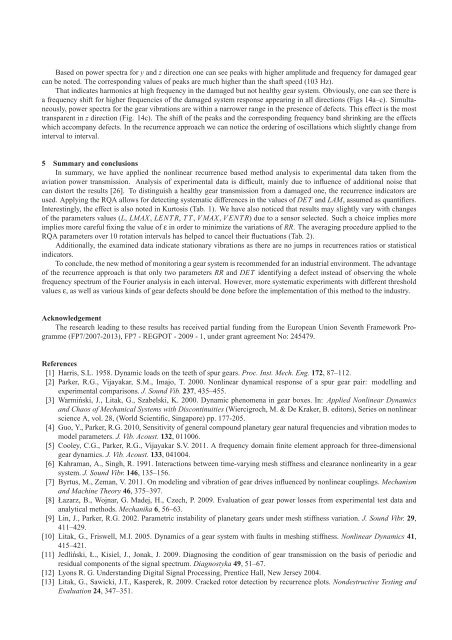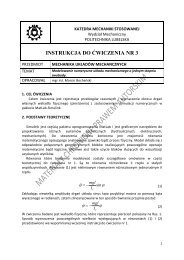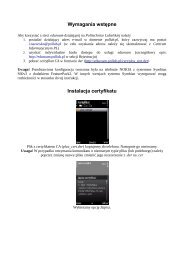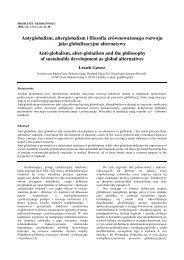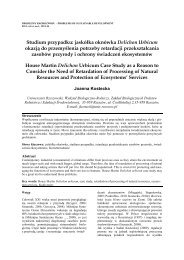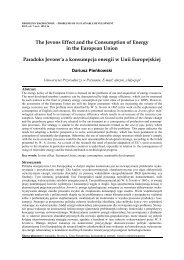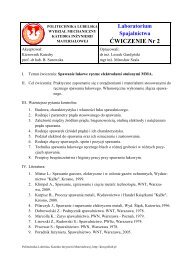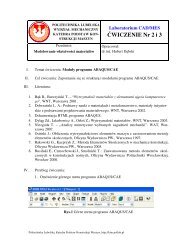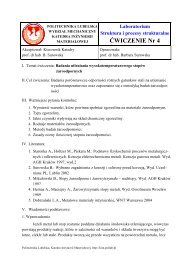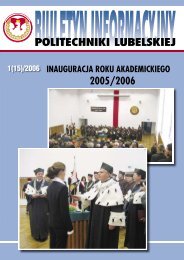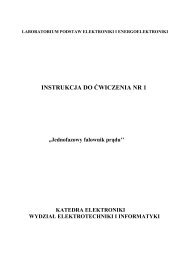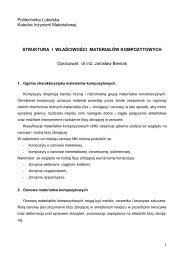pdf-preprint - Grzegorz Litak
pdf-preprint - Grzegorz Litak
pdf-preprint - Grzegorz Litak
Create successful ePaper yourself
Turn your PDF publications into a flip-book with our unique Google optimized e-Paper software.
Based on power spectra for y and z direction one can see peaks with higher amplitude and frequency for damaged gearcan be noted. The corresponding values of peaks are much higher than the shaft speed (103 Hz).That indicates harmonics at high frequency in the damaged but not healthy gear system. Obviously, one can see there isa frequency shift for higher frequencies of the damaged system response appearing in all directions (Figs 14a–c). Simultaneously,power spectra for the gear vibrations are within a narrower range in the presence of defects. This effect is the mosttransparent in z direction (Fig. 14c). The shift of the peaks and the corresponding frequency band shrinking are the effectswhich accompany defects. In the recurrence approach we can notice the ordering of oscillations which slightly change frominterval to interval.5 Summary and conclusionsIn summary, we have applied the nonlinear recurrence based method analysis to experimental data taken from theaviation power transmission. Analysis of experimental data is difficult, mainly due to influence of additional noise thatcan distort the results [26]. To distinguish a healthy gear transmission from a damaged one, the recurrence indicators areused. Applying the RQA allows for detecting systematic differences in the values of DET and LAM, assumed as quantifiers.Interestingly, the effect is also noted in Kurtosis (Tab. 1). We have also noticed that results may slightly vary with changesof the parameters values (L, LMAX, LENT R, T T , V MAX, V ENT R) due to a sensor selected. Such a choice implies moreimplies more careful fixing the value of ε in order to minimize the variations of RR. The averaging procedure applied to theRQA parameters over 10 rotation intervals has helped to cancel their fluctuations (Tab. 2).Additionally, the examined data indicate stationary vibrations as there are no jumps in recurrences ratios or statisticalindicators.To conclude, the new method of monitoring a gear system is recommended for an industrial environment. The advantageof the recurrence approach is that only two parameters RR and DET identifying a defect instead of observing the wholefrequency spectrum of the Fourier analysis in each interval. However, more systematic experiments with different thresholdvalues ε, as well as various kinds of gear defects should be done before the implementation of this method to the industry.AcknowledgementThe research leading to these results has received partial funding from the European Union Seventh Framework Programme(FP7/2007-2013), FP7 - REGPOT - 2009 - 1, under grant agreement No: 245479.References[1] Harris, S.L. 1958. Dynamic loads on the teeth of spur gears. Proc. Inst. Mech. Eng. 172, 87–112.[2] Parker, R.G., Vijayakar, S.M., Imajo, T. 2000. Nonlinear dynamical response of a spur gear pair: modelling andexperimental comparisons. J. Sound Vib. 237, 435–455.[3] Warmiński, J., <strong>Litak</strong>, G., Szabelski, K. 2000. Dynamic phenomena in gear boxes. In: Applied Nonlinear Dynamicsand Chaos of Mechanical Systems with Discontinuities (Wiercigroch, M. & De Kraker, B. editors), Series on nonlinearscience A, vol. 28, (World Scientific, Singapore) pp. 177-205.[4] Guo, Y., Parker, R.G. 2010, Sensitivity of general compound planetary gear natural frequencies and vibration modes tomodel parameters. J. Vib. Acoust. 132, 011006.[5] Cooley, C.G., Parker, R.G., Vijayakar S.V. 2011. A frequency domain finite element approach for three-dimensionalgear dynamics. J. Vib. Acoust. 133, 041004.[6] Kahraman, A., Singh, R. 1991. Interactions between time-varying mesh stiffness and clearance nonlinearity in a gearsystem. J. Sound Vibr. 146, 135–156.[7] Byrtus, M., Zeman, V. 2011. On modeling and vibration of gear drives influenced by nonlinear couplings. Mechanismand Machine Theory 46, 375–397.[8] Łazarz, B., Wojnar, G. Madej, H., Czech, P. 2009. Evaluation of gear power losses from experimental test data andanalytical methods. Mechanika 6, 56–63.[9] Lin, J., Parker, R.G. 2002. Parametric instability of planetary gears under mesh stiffness variation. J. Sound Vibr. 29,411–429.[10] <strong>Litak</strong>, G., Friswell, M.I. 2005. Dynamics of a gear system with faults in meshing stiffness. Nonlinear Dynamics 41,415–421.[11] Jedliński, Ł., Kisiel, J., Jonak, J. 2009. Diagnosing the condition of gear transmission on the basis of periodic andresidual components of the signal spectrum. Diagnostyka 49, 51–67.[12] Lyons R. G. Understanding Digital Signal Processing, Prentice Hall, New Jersey 2004.[13] <strong>Litak</strong>, G., Sawicki, J.T., Kasperek, R. 2009. Cracked rotor detection by recurrence plots. Nondestructive Testing andEvaluation 24, 347–351.


